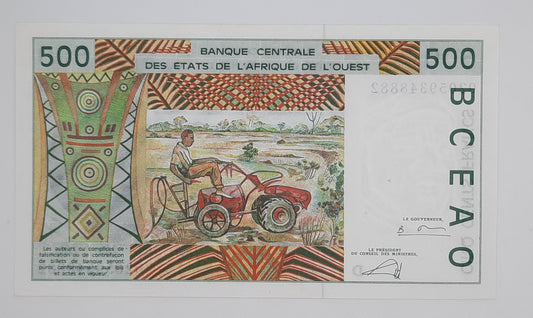Look up Country, Denomination or Year
-
2002 Mali, Banque Centrale Des Etats De L'Afrique L'ouest - 500 CFA Francs Banknote Serial No. 02059348882 P-410d
Vendor:notescounterRegular price £8.49 GBPRegular priceUnit price / per
Collection: Mali
Mali Banknotes – A Portrait of Post-Colonial Identity and West African Heritage
Explore the rich and evolving story of Mali’s currency, where post-independence ambition, regional symbolism, and artistic design converge. From its early years as a newly sovereign nation to its integration into the West African Monetary Union, Mali’s banknotes reflect a journey of national pride, economic transition, and cultural expression.
🏛️ A Brief History of Malian Currency
1960–1967: Following independence from France, Mali issued its own national currency under the Bank of the Republic of Mali, featuring denominations from 50 to 5,000 Francs. These notes were rich in local imagery, including agriculture, education, and traditional life.
1967–1984: The Central Bank of Mali continued issuing notes with updated designs and enhanced security features, maintaining the franc as the national currency.
1984–present: Mali joined the West African Monetary Union, adopting the West African CFA Franc (XOF) issued by the BCEAO (Banque Centrale des États de l'Afrique de l'Ouest). Since then, Mali has shared a common currency with several neighboring countries, though earlier national issues remain highly collectible.
🎨 Design Themes & Features
Malian banknotes are known for:
Portraits of everyday people, reflecting the dignity of labor and community
Scenes of agriculture, education, and industry, emphasizing national development
Traditional architecture and textiles, showcasing regional identity
Bright color palettes and fine engraving, often printed by renowned firms like Banque de France
📚 Why Collect Mali Banknotes?
Mali’s currency offers a compelling blend of:
Post-colonial history and sovereignty
West African cultural motifs
Scarce early issues and transitional designs
Whether you're drawn to the symbolism of independence, the artistry of early issues, or the regional significance of the CFA Franc, Mali banknotes provide a rich and rewarding collecting experience.

